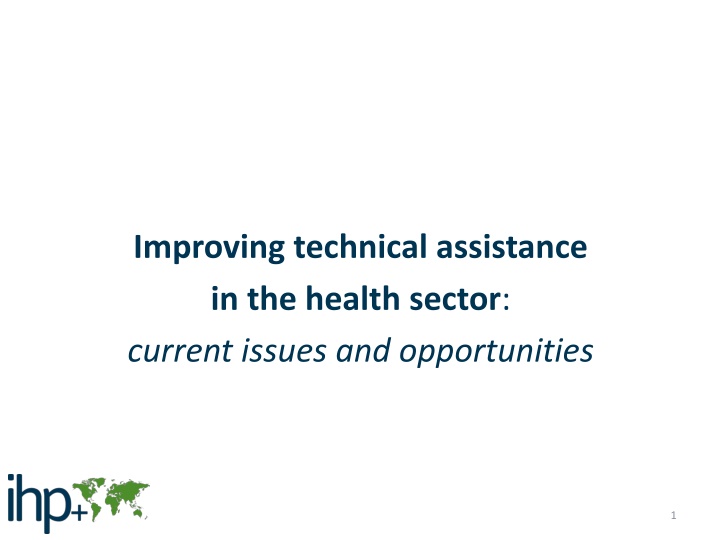Enhancing Health Sector Technical Assistance: Addressing Current Challenges and Promoting Opportunities
Discussion on improving technical assistance in the health sector, highlighting the need to revisit approaches to achieve demand-led, well-coordinated, and effective TA as concluded in the 2012 Nairobi CHTM discussions.
Download Presentation

Please find below an Image/Link to download the presentation.
The content on the website is provided AS IS for your information and personal use only. It may not be sold, licensed, or shared on other websites without obtaining consent from the author.If you encounter any issues during the download, it is possible that the publisher has removed the file from their server.
You are allowed to download the files provided on this website for personal or commercial use, subject to the condition that they are used lawfully. All files are the property of their respective owners.
The content on the website is provided AS IS for your information and personal use only. It may not be sold, licensed, or shared on other websites without obtaining consent from the author.
E N D
Presentation Transcript
Improving technical assistance in the health sector: current issues and opportunities 1
IHP+ Work on TA: Overview 2012 Nairobi CHTM discussions and conclusions: need to revisit how to achieve demand-led, well coordinated and effective TA February 2014: brainstorming meeting and creation of TA reference group April to July 2014: rapid country case studies September 2014: synthesis paper (included in file) October 2014: consultation involving country representatives, donors and academics (main messages included in file) Siem Reap: reviewed issues, agreed on key actionable messages 2
Rapid country reviews: six findings 1. There is frequently an inadequate level of understanding and agreement between donors and government over what is considered technical assistance and what is potentially on offer. 2. Health sector plans and strategies can help articulate demand for TA and coordinate TA supply. But strong sector plans do not necessarily mean that TA needs are well understood or addressed 3. Experience with TA policies, frameworks, tools, guidelines and mapping exercises is mixed. Stated principles are not always followed in practice. 3
4. Although capacity building is usually mentioned as an essential aspect of TA provision, capacity building objectives are not always explicit, nor are measures for assessing improvements in individual and institutional capacity well defined. 5. While capacity substitution/gap-filling remains a necessity in some situations, the potential methods to mitigate negative impacts are not receiving much attention 6. The individual characteristics of the TA provider and the building of trust are important for the TA to be effective 4
InSiem Reap: questions discussed How can governments at different levels of capability formulate their demand for TA? Is support to governments to articulate needs/demand adequate? How can health ministries and donors work together to identify which sector-wide TA tools are needed? How can we move from capacity substitution to capacity building? Could gap-filling be structured to lead to more sustainable forms of development? Is dual accountability a major problem? How can TA oversight arrangements be structured so that government as well as donor has a role in overseeing and monitoring TA outputs? How can the contribution of TA to individual and institutional capacity increases be assessed? 5
Siem Reap messages Findings from rapid country reviews were reinforced Priorities for action on TA including south-south cooperation: Technical assistance defined based on health sector priorities, and becomes more demand driven. Governments articulate needs more clearly; initiate dialogue with DPs on those needs. Development partners clearer about what technical assistance is available and how to access it, including through support for south-south and triangular cooperation. Joint definition of terms of reference with clear accountability and explicit capacity building objectives; ways to monitor relevance, quality, cost and impact of TA developed
Steering Committee is invited to discuss these messages and what actions can be taken by Steering Committee members other IHP+ partners IHP+ core team 7























